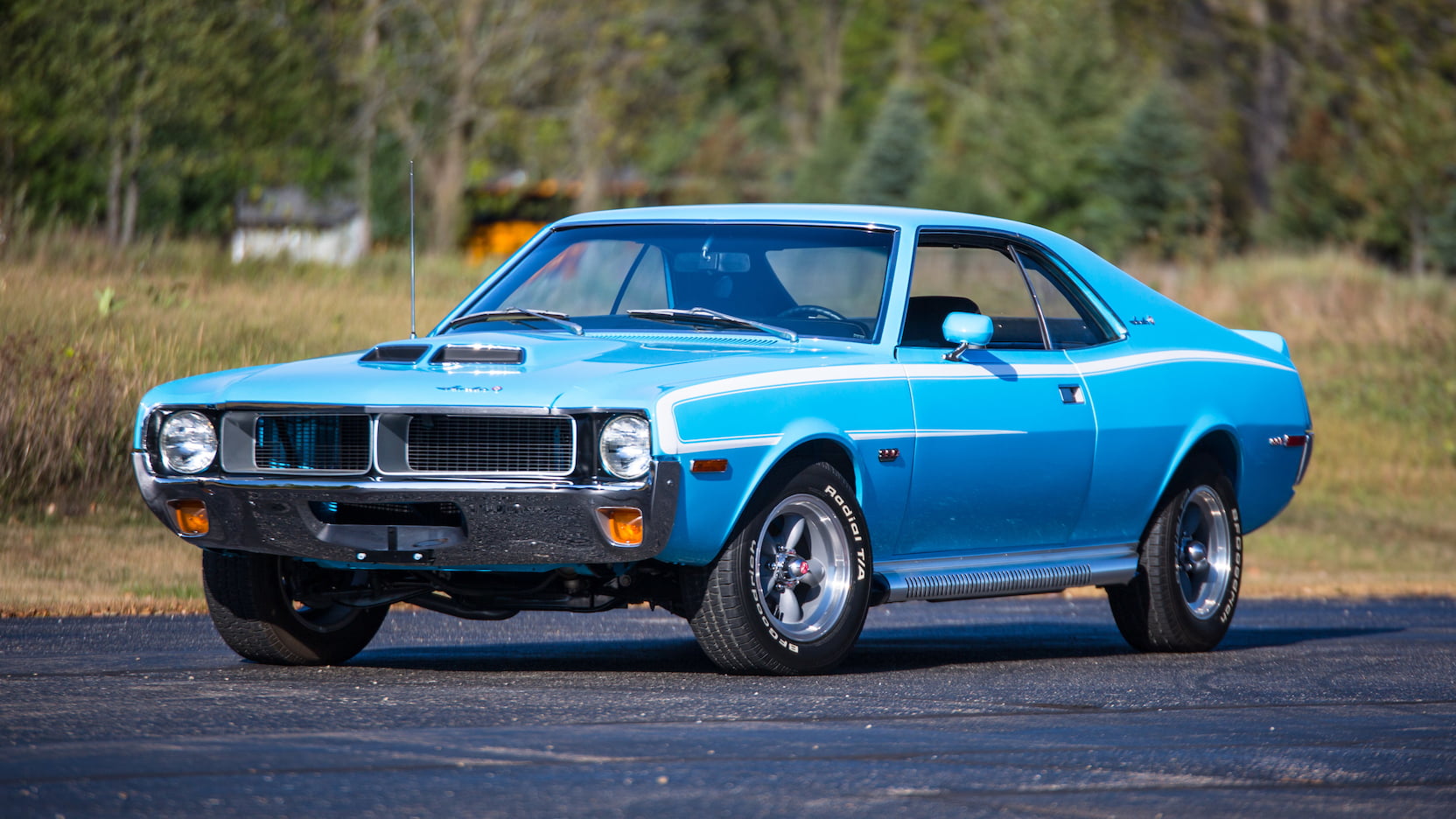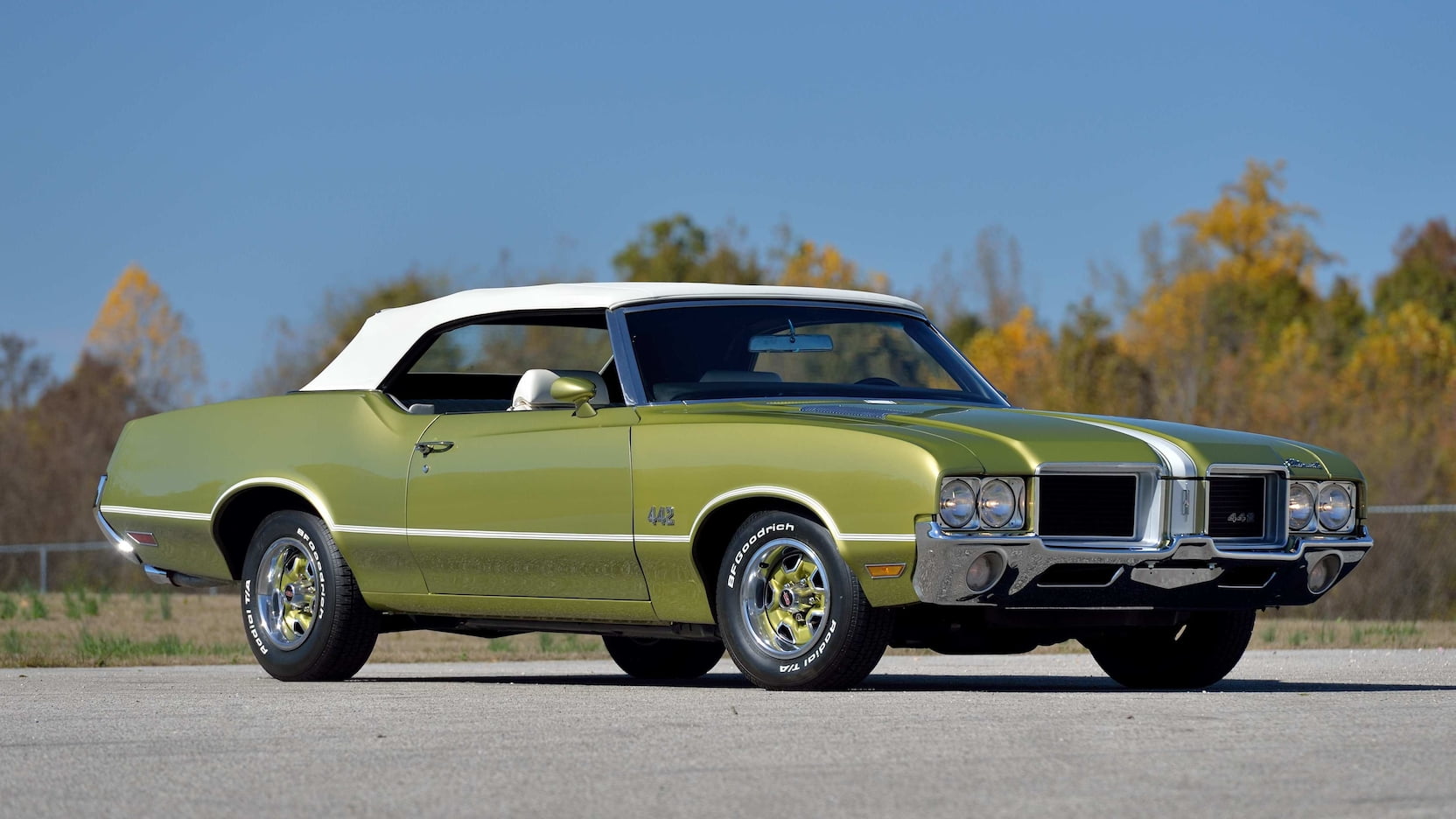28 little-known muscle car facts
March 6, 2023: Good day, fellow gearheads. There is a lot to report on coming out of the recent festivities at The Amelia, and much of that content features luxury brands and European marques. So we thought we’d treat our muscle fans to an old favorite article (September 4, 2019), lest you think we’ve lost our taste for tire-smoking Detroit iron. -Eric Weiner, Executive Editor
Want to impress your friends? Outsmart some loudmouth on Facebook? Just wanna get in the good graces of a certain tribe? Then take this here list to your local cruise and throw one at every faction under the Ambassador Bridge. Inspired by Steve Magnante’s 1001 Muscle Car Facts, this list an indispensable resource for any aspiring muscle-car know-it-all. In no particular order:
AMC

- Yes, there still are folks who think the 390 commonly found in AMXs is a Ford engine. It’s not.
- An urban legend suggests that the Trans Am-inspired 1970 Mark Donohue Javelin built with the standard 360 received stronger internal webbing (a feature of the 390) than run-of-the-mill 360s, but there’s no evidence of a special 360 having been factory-installed. AMC expert Ian Webb offers an explanation: AMC offered a service block with the aforementioned reinforcements but with the smaller bore of the 304 that is colloquially referred to as the “Trans Am block.” It is still unsubstantiated that this block was installed at the factory.
Buick

- The 1968-69 GS California was based on a regional model built in 1967. Interestingly, all were based on the Special series and not the Gran Sport.
- 1966 was the only year that there were three Gran Sport series: Skylark, Riviera, and Wildcat.
- The last year for an available four-speed for full-size cars was 1965.
Chevrolet

- It was possible to order a 1966–67 Chevelle with the 396 that wasn’t an SS 396. All you had to do was visit a Canadian dealership and order a Malibu coupe or convertible with the A51 package. It was called the “Sports Option” and included Strato-bucket seats, console (when paired with four-speed or automatic), rocker trim, contrasting rear cove trim (for 1966), and Malibu SS identification. An A51-equipped Malibu was the only way to score the 396.
- “Band-Aid” stripes for 1967–69 Camaros were an exclusive Z/28 feature. Exceptions: 1969 Z11 pace cars and the Z10 hardtop promotional model.
- For the 1968–69 Camaro SS and Nova SS, the L78 396/375 was more popular than the L34 396/350.
Dodge

- The Dodge Dart Swinger 340 was only available in 1969–70 in the U.S. but, due to the efforts of two dealerships, a handful of special-order Dart Swinger Specials with the 340 were available through 1972 in Canada.
- For 1970, if you wanted a 340 in a Dodge Challenger, you ordered the base model. In 1971, you could get the 340 in the Challenger or Challenger R/T.
- The 1969 Dodge Charger Daytona’s nose was made of sheet metal, not fiberglass.
Ford

- In 1971, the 429 Cobra Jet Mustang was the only Ford Motor Company product that officially offered the Drag Pack.
- The 429 Police Interceptor for 1971 full-size Fords was similar (but not identical) to the 429 Cobra Jet, including heads and camshaft.
- Despite the name, the 429 Cobra Jet was not standard for the 1970 Torino Cobra.
Mercury

- Ram air was not available with the 428 Cobra Jet for 1969 Mercury Montegos—only the Cyclone was available with air induction.
- The 1969–70 Marauder X-100 could have other contrasting rear two-toning besides matte black. It also was optional for the base Marauder.
- Mercury generally used the same engine codes in the VIN as did Ford but, for 1970, both the 428 and 429 Cobra Jet with ram air was designated differently by Mercury.
Oldsmobile

- Besides the Corvette, the 1971–72 Olds 4-4-2 was the only GM vehicle that offered a dual-disc clutch.
- The 4-4-2 package went from being based on F85 and Cutlass models in 1966 to the fancy Cutlass Supreme in 1967.
- The 1970 Cutlass SX had a confusing array of available engines: L33 2bbl. 455/320 was standard through March, replaced by the L31 4bbl. 455/365 from the full-size series. The W32 455/365 (the same engine standard on the 4-4-2) was optional throughout the year.
Plymouth

- Both the side stripe for the 1970 Duster 340 and the optional “Hockey Stick” stripe for the 1970 ‘Cuda were only available in black from the factory.
- Three Barracuda models were available with the 340 in 1969: standard, Formula S, and ‘Cuda 340.
- Strangely, the standard engine for the 1970 Sport Fury GT was not the same 375-horse 440 found in the GTX—it was the 350-horse version of the big-block.
Pontiac

- Black grilles were not a part of the Judge package for 1969. Rather, all ram air cars received black grilles. Since all Judges are ram air cars, black grilles have long been associated with the Judge.
- The last full-size four-speed was in 1968. Only 755 were built, with most being Catalinas according to the GM Heritage Center.
- All of the 1969 Grand Prix Model J’s four-barrel engines were available with a standard three-speed. The Model SJ shared some of the same engines but required a four-speed or automatic.
Shelby

- The initial run of 1967 Shelby Mustangs had driving lights in the middle of the grille. However, some states had rules on the close proximity of lights, so Shelby made a running change and later cars received lights at the outer edges of the grille.
- Ford’s Grabber colors got their start with the 1969 Shelby Mustang.
***
Check out the Hagerty Media homepage so you don’t miss a single story, or better yet, bookmark it. To get our best stories delivered right to your inbox, subscribe to our newsletters.


And in 1969, in many installations, the 396 was actually a 402.
That’s actually 1970 and beyond.
heard a story that there was a flood at the engine block facility and the blocks got wet and rusted. instead of scrapping them they honed or bored the the cylinder walls and used them. Don’t really know the truth behind this!
AMC had to produce a certain amount of engines to qualify for use in Trans Am. AMC made 360’s in a limited amount for this purpose but had to get them out in production cars/trucks. Every once in a while we would see a “RED ENGINE” 360 in a Jeep. I found a factory manager that told me this was the Trans Am engine block. All other production engines for AMC were blue.
A great read thanks for the info
What constitutes a strong power to weight ratio? I have never read or heard the minimum value required to be a muscle car. Is a Gremlin X or a Cosworth Vega a muscle car? There will never be complete agreement on the definition of muscle car. The power to weight ratio is just another criteria to debate.
Back in the 1960’s, a ratio of less than 9 lbs/hp was considered as a benchmark for high hp cars. That was based on the advertised hp back then. Not necessarily a definition for muscle cars, but one drag racers looked at.
Black grilles were not a part of the Judge package for 1969. Rather, all ram air cars received black grilles. Since all Judges are ram air cars, black grilles have long been associated with the Judge.
?Huh?
OK, can someone translate this paragraph for me? Is he stating that they indeed all had black grills but not for the reason we think? Is a black grill with grey accent paint (in the pic) still a black grill?
Black grilles are not a Judge feature but a ram air feature.
just curious. How did you rate the 1968 Cougar XR7? Mine has a 134k, is driven regularly and the Carb, A/C Compressor were replaced after 54 years and will over over a 120 thousand miles. Interior is perfect. Gone through one dual muffler change. Reliable as hell. We changed the A/C because we moved to Florida. Was adequate in the northeast.
We have in 73k replaced the rely switch (19$) the fuel pump 29$ and 25$ for labor and changed the leaf springs which did not need replacement. Driven it 73k over 20 years and have put under 3k on the car in mainenance. Tires have 73k on them and soon will need replacement. One brake job on one axle and one tail pipe hangar. Orignial resonators. No rust anywhere.
I own a 1970 Olds 442 convertible with 455 W30, turbohydro, Hurst dual-gate shifter. It was a factory-executive car originally driven by the Oldsmobile District Sales Manager. It’s a one-owner that I originally sold to a college room-mate , and traded back in in ’79 with 72,000 miles. looks and runs like new,. As you probably know, that was the last year of the high-compression engines before unleaded fuel .
I had a 1969 Camaro that had a urethane front bumper. Every ’69 Camaro I’ve seen since has a chrome front bumper. Was the urethane bumper a limited run or something?
It was an option.
All the memories of the days gone by. I had a 69 Mach 1 with a 390 4bbl and a 4-spd tranny. What a fun car that I wish I still had. The backseat may have not been comfortable, especially if you got stuck in the middle for a long trip, but the front buckets were great. You forgot to mention the Mercury Cougar in your walk down memory lane.